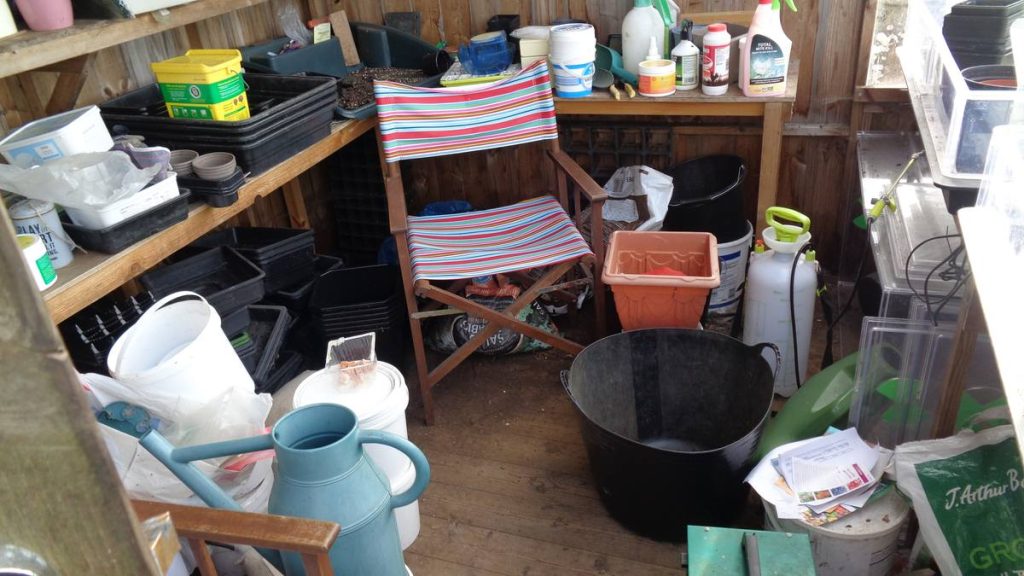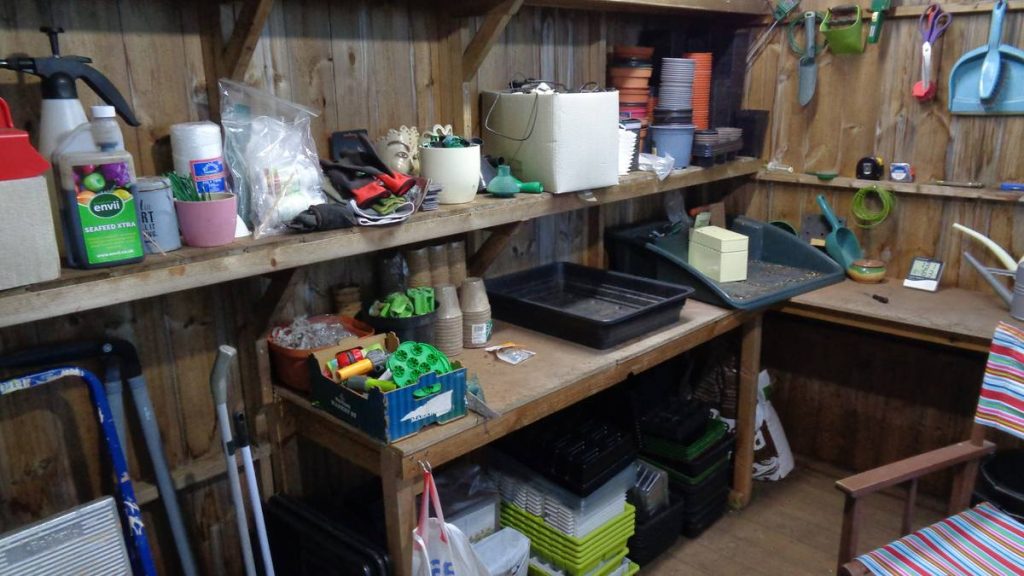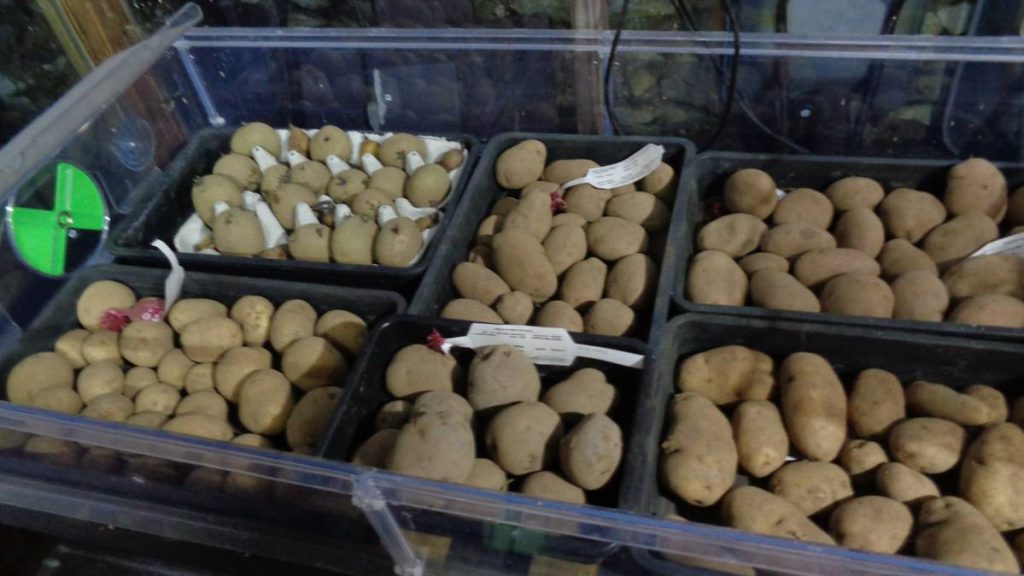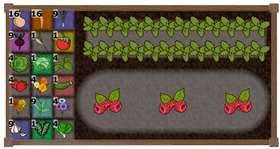Preparing for the new growing season by getting the potting shed cleared for action and setting the potatoes out to chit.
I wasn’t sure if it was wise to post this. My reputation as someone tidy and organised will be destroyed. Still, maybe it will help others in the same position take heart. I’ve been talking about tidying up the potting shed for months but never seem to get around to it. Anyway, when it was getting difficult to even get in the shed, decided to face up to it.
Tidying the Shed
What a job! It’s all those things that should have been put in their place but got left on the side. It’s actually quite satisfying creating order from chaos but there’s one part I hate. That’s when you sweep up some spilled compost and a lump grows 8 legs and scuttles off.
Yes, I have a phobia about spiders. Snakes, no problem. Rats don’t scare me but I’d rather face an angry pit bull than a spider. Been that way since I was a toddler, so I doubt I’ll stop quaking at the sight of them now.
It basically took a good chunk of a day to clear and tidy the stuff on the floor alone. Some things belonged in the big shed and more in the bin. Then it was time to tackle the shelves. Lots of ‘Oh! That’s where it was.’ moments. So, all the shelves organised again, floor tidied and swept I’m ready to start the season in earnest.
Chitting Potatoes
The second part of my seed potato order arrived and I wanted to set them out for chitting. In the past I’ve had them out in the shed on the bench and used my thermostatically controlled fan heater to make sure they don’t freeze on cold nights .
This year I’ve cut back on the quantity of potatoes. I tend to grow too many normally so I’m cutting down my workload. With energy costs through the roof I want to save where I can as well. Instead of using the fan heater to keep the whole shed frost free, I’ve put the potatoes into the Vitopod. It’s set at 8ºC so they won’t get frosted and use a lot less power. The Vitopod uses 100 watts against the fan heater’s 2,000 watts.
This year I’m growing the following potatoes which should give us a harvest of around 90kg.
Casablanca
First early, some already planted in the polytunnel the rest destined for the new four metre raised bed by the polytunnel.
Salad Blue
This is a new one to me, a blue-fleshed, multi-purpose heritage variety potato. The blue flesh is a bit of a talking point and should impress my grandson. It’s either a Second Early or an Early Maincrop depending who’s selling it. Strangely it doesn’t seem to be mentioned in Roman’s potato book either.
Orla
Orla does fairly well here and it’s a decent all-rounder, white potato. Known as an Early Maincrop or First Early depending who you ask, Orla can be harvested young or left to grow on. It’s got some foliar blight resistance but good tuber resistance so I tend to grow it on until blight strikes.
Sarpo Kifli
The Sarpo version of Charlotte with a similar feel and flavour but Sarpo blight resistance. A very Early Maincrop that stores well.
Sarpo Axona
A lovely Maincrop red potato that keeps really well. Like its sister Sarpo Mira, if left in the ground it just keeps growing but I feel it’s best lifted around 22 weeks rather than leaving longer. Being a Sarpo it’s highly blight resistant and again, like Mira, a vigorous plant that will shade out most weeds.
Sarpo Mira
The first of the Sarpo varieties here introduced in 2002 it was miraculous how well it stood up to blight. It’s the most vigorous potato I’ve come across, a real thug. I’ve found it actually needs greater spacing than most maincrops to give of its best – 50 to 60cm in the row and a row spacing of up to 100cm.
It’s best described as late Maincrop but I’ve found leaving it too long to grow on risks hollow heart. That’s also a problem when the weather includes long dry periods followed by very wet as the tubers develop. The tubers can be huge,bigger than any other potato I’ve grown. The late tubers also become very starchy at the end as well.
The flesh is unusual, very dense. I think this is why, even in bad years, slug damage is minimal. We’ve found it isn’t a great roasting or chipping potato but it makes fantastic mash and holds together very well in dishes like potatoes boulangère or dauphinoise. It’s an OK baker but the larger tubers are often poorly shaped for baking.
It’s final virtue is that it stores really well. It always lasts us until the new potatoes are well in.
 Potatoes – A Guide to Growing Harvesting and Storing
Potatoes – A Guide to Growing Harvesting and Storing
Full colour, downloadable e-book that tells you all you need to know to grow great potatoes.
Over the years I have written much about the humble potato. Through articles and books I have covered everything from how many to grow, how to grow them, how to store them, growing for show, and what diseases or other problems a grower may encounter. I’ve even given talks on growing the simple spud! Now an e-book solely about the potato, all that knowledge all in one place.
Full information chapter list and special offer details here.







I love seeing normally organized people’s messy closets! (or potting sheds)
No matter how much I tell myself I will keep it organized, I have to go in there once every few weeks and do a full re-stack and sweep up.
I love the variety of potatoes – how did you choose these ones to keep?
I tend to try a new variety most years, some just the once and others move up my rankings. There’s just so many potato varieties to choose from but it comes down to what you like and what grows well in your plot.
Hello! I saw your post in 2015 when you bought a brand new Swallow Jay potting shed, can I ask if you still have the same one? Or is this a new one?
This is the same shed – it’s had a couple of coats of Cuprinol and is keeping well. Still untidy though 🙁